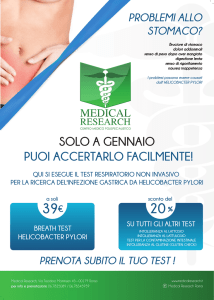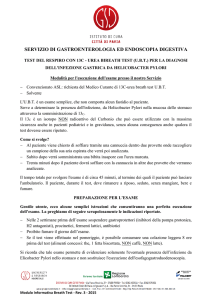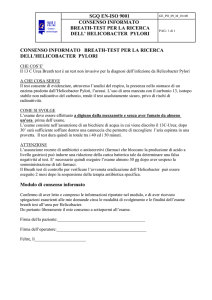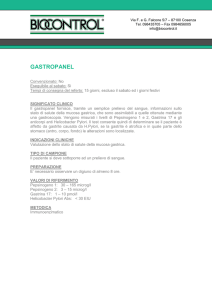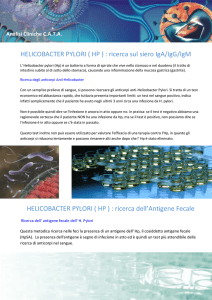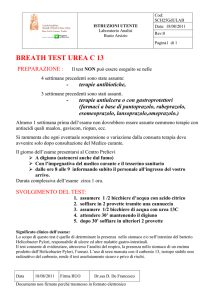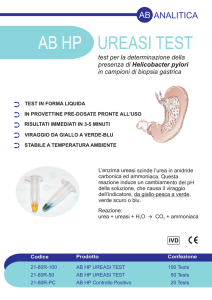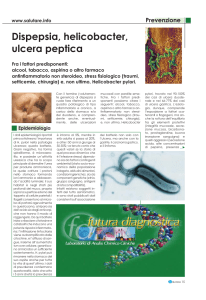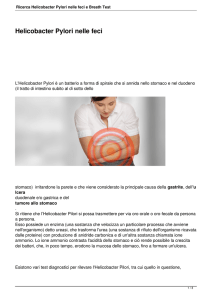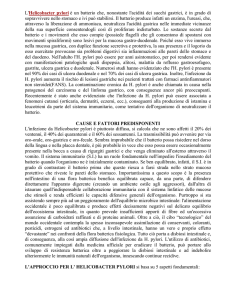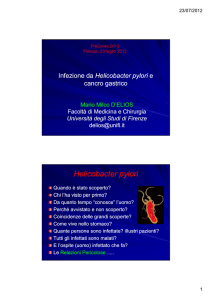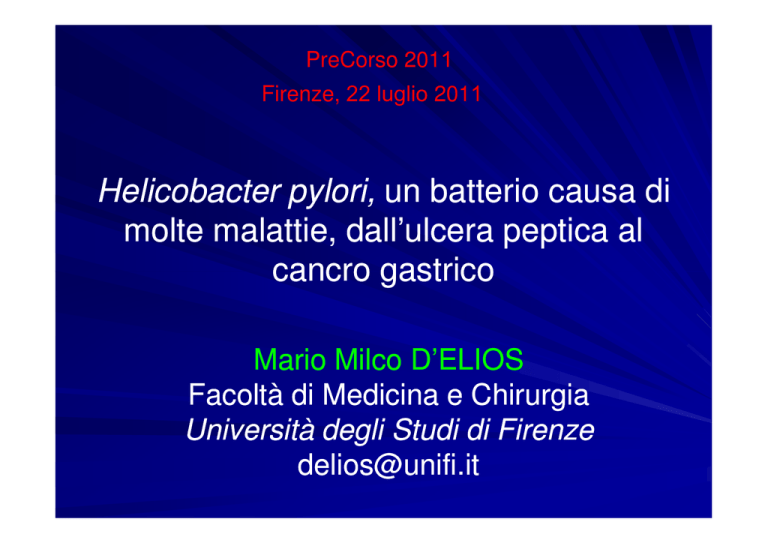
PreCorso 2011
Firenze, 22 luglio 2011
Helicobacter pylori,
pylori, un batterio causa di
molte malattie, dall’ulcera peptica al
cancro gastrico
Mario Milco D’ELIOS
Facoltà di Medicina e Chirurgia
Università degli Studi di Firenze
[email protected]
Helicobacter pylori
Quando è stato scoperto?
Chi l’ha visto per primo?
Da quanto tempo “conosce” l’uomo?
Perché avvistato e non scoperto?
Coincidenze delle grandi scoperte?
Come vive nello stomaco?
Quante persone sono infettate? iIlustri pazienti?
Tutti gli infettati sono malati?
E l’ospite (uomo) infettato che fa?
Le Relazioni Pericolose .....
The Nobel Prize in
Physiology or
Medicine 2005
"for their discovery of the bacterium
Helicobacter pylori and its role in gastritis and
peptic ulcer disease"
b. 1951
Barry J. Marshall
Australia
Helicobacter pylori
Research
Laboratory, QEII
Medical Centre;
University of
Western Australia
Australia
J. Robin Warren
Australia
Perth,
Australia
b. 1937
E 100 anni prima
Premio Nobel
a chi?
The Nobel Prize in
Physiology or
Medicine 1905
"for his investigations and
discoveries in relation to
tuberculosis"
Robert Koch
Germany
Institute for Infectious
Diseases
Berlin, Germany
b. 1843
d. 1910
Helicobacter pylori
quando è stato scoperto?
Cultured for the first time on Easter Thursday 1982
–Patient 37, 70y.o. male
–DU, GU, artificial valve, anticoagulants
� MRSA epidemic at Royal Perth
–Overworked microbiology technologists
– No time to check the culture on Saturday
–Not examined until Tuesday Not examined until Tuesday
–Gram negative rods seen in pure culture
� We had been using the right methods for
–Cultures were being discarded after 48 hours
From the 2005 Nobel Lecture by Barry Marshall
… e 100 anni prima?
The first report on the etiology of tuberculosis was
presented on March 24, 1882 in Berlin.
Helicobacter
chi l’ha visto per primo? quando
quando?
?
Giulio Bizzozzero
1893,
1893, Arch f mikr Anat 42:
42: 82
82--152.
152.
”Ueber die schschlauchformigen drusen
des
magendarmkanals
und
die
bezienhungen ihres epithels zu dem
oberflachenepitel der schleimhaut
schleimhaut..”
1892,
1892, Atti della Reale Accademia
delle Scienze di Torino 28:
28: 233
233--251.
251.
”Sulle
ghiandole
tubulari
del
tubo
gastroenterico e sui rapporti del loro epitelio
coll’epitelio di rivestimento della mucosa
mucosa..”
Helicobacter
altri avvistamenti
La presenza di batteri spiraliformi nello stomaco fu descritta
a più riprese nel secolo scorso, tra gli altri da Freedberg nel
1940 a Steer e ColinColin-Jones nel 1975
1975..
Ito descrisse e fotografò batteri spiraliformi in biopsie
derivate dal suo stomaco, nel suo famoso Textbook of
Physiology del 1966.
1966.
Tra gli anni 20 e 50 del ‘900 altri scienziati, quali Luck e
Fitzgerald,
Fitzgerald, comprovarono la presenza di attività enzimatica
di tipo ureasica
ureasica nello stomaco di gatti e cani.
cani.
Nel 1959 Lieber dimostrò che l’attività ureasica gastrica
poteva essere soppressa con una terapia antibiotica a base
di tetracicline
tetracicline.. Nel 1968 Delluva osservò che animali
mantenuti in condizioni asettiche non presentavano attività
ureasica nello stomaco
stomaco..
Ma…
Ma…la presenza di batteri nello stomaco e l’attività ureasi
ureasica
ca
non furono poste in relazione all’insorgenza di patologie
gastroduodenali
Modificato da Warren e Marshall 2005 Nobel Lecture
H. pylori
perché avvistato e non scoperto?
Acid environment kills organisms
The normal stomach is sterile
Bacteria seen are contaminant passing
through, dead or secondary to gastric
lesions such as peptic ulcer
ulcer.. Just a
secondary infection, due to gastritis
“If it is true, why were they not recognised
before…
before…”
(From the 2005 Nobel Lecture by Robin Warren))
… perché?
“L’uomo, per sua natura, ha più paura
della verità che della morte…
morte…”
Soren Kierkegaard
“…Il più grande ostacolo alla conoscenza
non è l’ignoranza bensì l’illusione della
conoscenza”
Daniel Boorstein
Warren First Report
(From the 2005 Nobel Lecture by Robin Warren))
H. pylori
black bacilli line the pits, easily seen (silver stain)
(From the 2005 Nobel Lecture by Robin Warren))
Lancet Letters 1983
A new species
Bacteria linked to gastritis
- “since the new bacteria are associated with gastritis as
described by Warren, then they may play a role in other
poorly understood gastric diseases i.e. peptic ulcer and
gastric cancer.”
From the 2005 Nobel Lecture by Barry Marshall
Koch’s Postulates …
1. The same organism must
be present in every case
of the disease.
3. The isolate must cause
the disease, when
inoculated into healthy,
susceptible animal.
2. The organism must be
isolated from the
diseased host and grown
in pure culture.
Koch’s Postulates and H. pylori………
From the 2005 Nobel Lecture by Barry Marshall
H. pylori e pazienti nei secoli
Napoleone
Napoleone,, a 52 anni, morì di
“ulcera
antrale
maligna”
(cancro gastrico
gastrico)). Così suo
padre, suo nonno, almeno un
fratello, una sorella
sorella..
Alfred Nobel soffriva di ulcera
peptica!
James Joyce morto di ulcera
duodenale perforata.
Traces of human migrations in H. pylori
populations
da quanto tempo “conosce” l’uomo?
Falush et al, Science 2003
H. pylori and related clinical outcomes
Helicobacter pylori
infection
Superficial gastritis
Chronic gastritis
Chronic active gastritis
MALT BB-cell
Lymphoma
Peptic
ulcer
Atrophi
Atrophicc gastritis
Gastric
adenocarcinoma
H. pylori, host response, and related
clinical outcomes
Bacterial factors (different strains,
pathogenicity island)
Host factors (genetics, cytokine / chemokine
network, gastrin, somatostatin, pepsinogen,
regulation of acid secretion)
Inflammation (site, type, etc)
“..Qui
“..
Qui pourrait ne pas frémir en songeant aux malheureux
qui ont causé une seule liaison dangereuse ...”
P. Choderlos De Laclos
Les liaisons dangereuses
D’Elios et al., J Immunol 1997; Gastroenterology 99, 2001; PNAS 2003; J Exp Med 2003
Trends Mol Med 2004; J Clin Invest 2006; Helicobacter 2009;
Cancer Immunol Immunother 2009, Expert Rev Anti Infect Ther 2010


